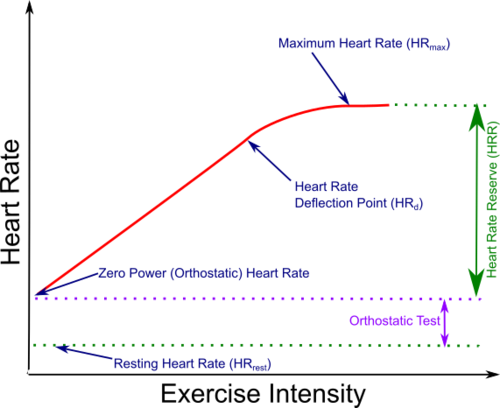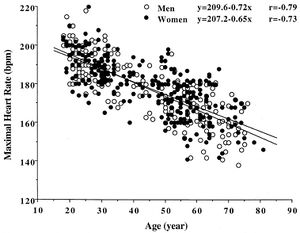Difference between revisions of "Maximum Heart Rate"
User:Fellrnr (User talk:Fellrnr | contribs) (Created page with "A simplified chart of heart rate against exercise intensity showing [[Maximum Heart Rate, Heart Rate Reserve, [[Resting Hea...") |
User:Fellrnr (User talk:Fellrnr | contribs) m |
||
| Line 38: | Line 38: | ||
=Does HR<sub>max</sub> vary by sport?= | =Does HR<sub>max</sub> vary by sport?= | ||
| − | It is often suggested that HR<sub>max</sub> varies with the mode of exercise. If you consider HR<sub>max</sub> to be the highest Heart Rate that the heart is capable of achieving, then this makes no sense. However, some sports do not use sufficient amounts of muscle to max out the heart rate. If you consider an extreme example, doing bicep curls would not demand enough oxygen to raise the heart rate to HR<sub>max</sub>. This means that sports like cycling, which use a smaller number of muscles than running, will not raise the heart rate to HR<sub>max</sub>. However, there will be a highest heart rate for that sport, and using that value as HR<sub>max</sub> may be useful as the sport specific HR<sub>max</sub> will reflect how hard the working muscles are being used. So if you have a HR<sub>max</sub> of 200 while running, but 180 while cycling, then it is appropriate to use a 'HR<sub>max</sub>' of 180 for cycling activities. So exercising at 75% of HR<sub>max</sub> would be 150 when running and 135 while cycling. The lower Heart Rate when cycling will reflect the fact that the heart and lungs are not working as hard when running as when cycling, but the active muscles should be performing at a similar level. | + | It is often suggested that HR<sub>max</sub> varies with the mode of exercise. If you consider HR<sub>max</sub> to be the highest [[Heart Rate]] that the heart is capable of achieving, then this makes no sense. However, some sports do not use sufficient amounts of muscle to max out the heart rate. If you consider an extreme example, doing bicep curls would not demand enough oxygen to raise the heart rate to HR<sub>max</sub>. This means that sports like cycling, which use a smaller number of muscles than running, will not raise the heart rate to HR<sub>max</sub>. However, there will be a highest heart rate for that sport, and using that value as HR<sub>max</sub> may be useful as the sport specific HR<sub>max</sub> will reflect how hard the working muscles are being used. So if you have a HR<sub>max</sub> of 200 while running, but 180 while cycling, then it is appropriate to use a 'HR<sub>max</sub>' of 180 for cycling activities. So exercising at 75% of HR<sub>max</sub> would be 150 when running and 135 while cycling. The lower [[Heart Rate]] when cycling will reflect the fact that the heart and lungs are not working as hard when running as when cycling, but the active muscles should be performing at a similar level. |
=What does HR<sub>max</sub> mean? Is higher better?= | =What does HR<sub>max</sub> mean? Is higher better?= | ||
Revision as of 17:08, 10 April 2012

Maximum heart rate (HRmax) is the fastest rate the heart is capable of beating. Like any muscle there is a limit to how fast the heart can contract, and this limits how fast the heart can beat. This maximum heart rate is not a "safe limit", but a physiological limit. It is not possible to exercise and push your heart rate beyond its maximum; if you see your heart rate go higher than the previously recorded maximum all you're doing is redefining what the maximum value is.
Contents
1 Maximum heart rate test
Maximum heart rate is measured by recording the heart rate while steadily increasing the exercise load. There will come a point where the exercise load increases, but the heart rate stays constant and this is the maximum heart rate. Obviously this test involves very high intensity exercise which by the very nature has some degree of risk. It is generally advised the maximum heart rate test is performed under medical supervision. However, athletes that are confident in their health will occasionally do an informal maximum heart rate test using the ordinary heart rate monitor watch. After a good Warmup, all that is needed is to start running a hard pace and rapidly increase the intensity to all out. The maximum heart rate recorded in is obviously HRmax.
2 Calculating maximum heart rate
There are various formulas for calculating HRmax based on age. However these formulas are a statistical approximation, so the actual HRmax could vary significantly. An analogy would be estimating your weight from your height; you can get a value, but he could be out so far as to be worse than useless. The chart below shows how the measured HRmax varies with age. There is an obvious correlation, but you can also see the variation from the average. If we consider age 50, the average HRmax is 173, but there are people in the study with an actual HRmax that is as low as 158 and as high as 200. If a 50 year old athlete is aiming to work out at 75% of HRmax, then the calculated HRmax would indicate that 130 BPM is the right intensity. If their actual HRmax is 158, then they are working out at 82% of HRmax, which is a lot higher. On the other hand, if their actual HRmax is 200, then they are working out at 65% of HRmax which is too low. This means that the calculated HRmax should be used with caution.

| Age | HRmax | Age | HRmax | Age | HRmax | Age | HRmax | Age | HRmax | Age | HRmax | Age | HRmax |
|---|---|---|---|---|---|---|---|---|---|---|---|---|---|
| 20 | 194 | 30 | 187 | 40 | 180 | 50 | 173 | 60 | 166 | 70 | 159 | 80 | 152 |
| 21 | 193 | 31 | 186 | 41 | 179 | 51 | 172 | 61 | 165 | 71 | 158 | 81 | 151 |
| 22 | 193 | 32 | 186 | 42 | 179 | 52 | 172 | 62 | 165 | 72 | 158 | 82 | 151 |
| 23 | 192 | 33 | 185 | 43 | 178 | 53 | 171 | 63 | 164 | 73 | 157 | 83 | 150 |
| 24 | 191 | 34 | 184 | 44 | 177 | 54 | 170 | 64 | 163 | 74 | 156 | 84 | 149 |
| 25 | 191 | 35 | 184 | 45 | 177 | 55 | 170 | 65 | 163 | 75 | 156 | 85 | 149 |
| 26 | 190 | 36 | 183 | 46 | 176 | 56 | 169 | 66 | 162 | 76 | 155 | 86 | 148 |
| 27 | 189 | 37 | 182 | 47 | 175 | 57 | 168 | 67 | 161 | 77 | 154 | 87 | 147 |
| 28 | 188 | 38 | 181 | 48 | 174 | 58 | 167 | 68 | 160 | 78 | 153 | 88 | 146 |
| 29 | 188 | 39 | 181 | 49 | 174 | 59 | 167 | 69 | 160 | 79 | 153 | 89 | 146 |
3 Does HRmax decline with age in athletes?
There is some evidence that HRmax may not decline as rapidly in endurance trained athletes as it does in the sedentary population. For instance, Jack Daniels looked at elite athletes in the 1968 Olympic games and then repeated the study 25 years later[2]. The athletes studied had a reduction in HRmax of only two BPM. However, another study[3] showed HRmax declining from 184 BPM at age 28 to 165 BPM at age 60, which is 19 BPM in 25 years, or 0.76 BPM/year, close to the average.
4 Does HRmax vary by sport?
It is often suggested that HRmax varies with the mode of exercise. If you consider HRmax to be the highest Heart Rate that the heart is capable of achieving, then this makes no sense. However, some sports do not use sufficient amounts of muscle to max out the heart rate. If you consider an extreme example, doing bicep curls would not demand enough oxygen to raise the heart rate to HRmax. This means that sports like cycling, which use a smaller number of muscles than running, will not raise the heart rate to HRmax. However, there will be a highest heart rate for that sport, and using that value as HRmax may be useful as the sport specific HRmax will reflect how hard the working muscles are being used. So if you have a HRmax of 200 while running, but 180 while cycling, then it is appropriate to use a 'HRmax' of 180 for cycling activities. So exercising at 75% of HRmax would be 150 when running and 135 while cycling. The lower Heart Rate when cycling will reflect the fact that the heart and lungs are not working as hard when running as when cycling, but the active muscles should be performing at a similar level.
5 What does HRmax mean? Is higher better?
There is no correlation between HRmax and performance, and HRmax cannot be used as a way of evaluating training or fitness. There is possibly a slight reduction in HRmax is fitness increases. This may be because fitness increases the size of the heart, and larger muscles move more slowly.
6 HRmax, HRrest and Heart Rate Reserve
It is possible to evaluate exercise intensity as a percentage of HRmax, but this is a flawed approach as it does not take into account the Resting Heart Rate (HRrest). It is better to use Heart Rate Reserve, which is based on the difference between HRmax and HRrest.
7 See Also
8 References
- ↑ Age-predicted maximal heart rate revisited 10.1016/S0735-1097(00)01054-8 : Journal of the American College of Cardiology | ScienceDirect.com http://www.sciencedirect.com/science/article/pii/S0735109700010548
- ↑ Pete Pfitzinger - Lab Reports - Slowing Down With Age http://pfitzinger.com/labreports/age.shtml
- ↑ Endurance exercise performance in Masters athletes- age-associated changes and underlying physiological mechanisms http://jp.physoc.org/content/586/1/55.full.pdf